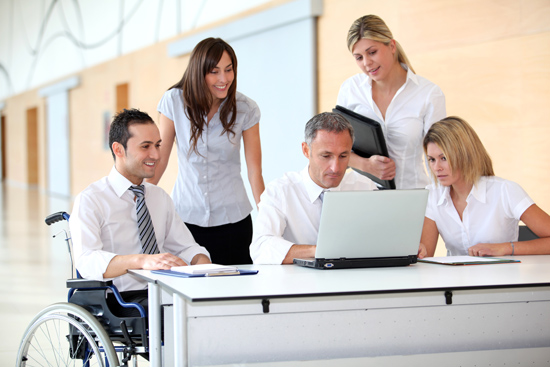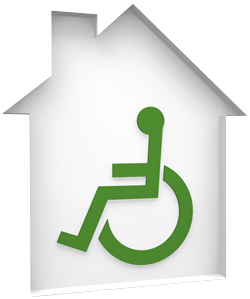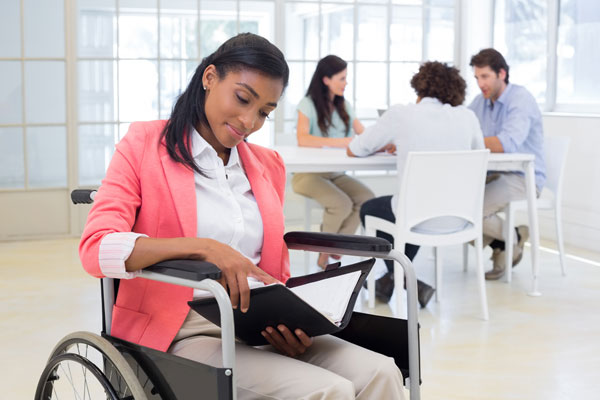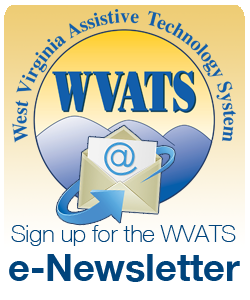Accessible Meetings
Download a PDF of this Document

To have a successful meeting, it is important for planners to understand that many participants may be individuals with disabilities or people who have other special needs. This information brief provides a few key points for planners to consider as they organize a conference or meeting.
The goal of any meeting should be to ensure the meeting is accessible to all participants, and to plan the meeting in a way that allows people with disabilities to fully participate. As the age of the workforce continues to rise, planners need to consider that participants will have both visible and hidden disabilities. While many people may not selfidentify as being a person with a disability, almost 30 percent of adults in the United States have difficulty with basic movement or sensory concerns.
One way to address the potential concerns of meeting participants is to try to use the principals of Universal Design in your planning process. In other words, plan the meeting to accommodate the needs of the greatest number of people, regardless of age, size or ability. This will help increase the likelihood that your event will have a successful outcome.
Facility
Where you hold your meeting is a critical issue. The Americans with Disabilities Act (ADA) has had a large impact on accessibility for public accommodations including many places where meetings are held. Its requirements for entrances, restrooms, paths of travel, signage, etc. help insure that facilities built today, and renovations done to older buildings, create an accessible environment. Keep in mind, however, that although the facility may claim to be accessible, the site may not be. You should make every attempt to find a facility that has the greatest level of accessibility. To do this, you can use an accessibility checklist. Visit the site ahead of time to make sure it is accessible, and involve people with different disabilities in the site assessment.
Helpful Hints/Suggestions:
- Use assistive technology to create an accessible environment. This can be either temporary or a permanent installment.
- Temporary modifications can help remove barriers and increase access. Consider tape to stripe lots for extra parking, temporary signage or portable ramps.
- Check to see if site will be under construction or create other barriers.
- Require a deadline date from the facility if modifications are planned.
Meeting Room
The meeting room is probably where the majority of your meeting activities will take place. It is important that the space be accessible, but also comfortable and accommodating to special needs.
Helpful Hints/Suggestions:

- Provide signs throughout the facility to let participants know where the meeting/conferece room is located.
- Ensure there are accessible restrooms on same floor as meeting area.
- Set-up the room to allow for movement of wheelchairs and other mobility aids. Different types of room set-up (classroom, theater, etc.) have different considerations for accessibility.
- Check room for lighting, drapes that close and availability of electrical outlets.
- Provide accessible seating, dispersed around room so people with disabilities have a choice about where they sit.
- Request a raised speaker platform and head table if meeting is in a large room.
- Provide convenient location for breaks, registration, etc.
- If tablecloth/draping is used, make sure it is at a height that does not interfere with wheelchairs or create a tripping hazard for participants.
- Make sure registration table and catering tables are at accessible height.
- Check for potential safety hazards, i.e., extension cords on carpets.
Communicating
To be successful, it is important that you be able to communicate with your participants and that they be able to communicate with you. This can be verbal, visual or remote communication.
Helpful Hints/Suggestions:
- Consider using assistive technology, temporary or permanent, such as assisted listening devices.
- Use teleconferencing - test connection before meeting to make sure it works.
- Record meeting proceedings.
- Use microphones for presenters and for taking questions from the audience.
- Use accessible/alternate formats for meeting materials, conference announcements and handouts, and make sure you have extra copies available.
- Develop accessibility guidelines for speakers, and suggest speakers repeat questions from the audience and describe power point slides.
Conference Features
Some participants may have special requests that must be considered when planning a meeting. While many may only affect the individual, such as interpreters, some may impact the entire group (e.g. room temperature). Regardless, they are important considerations for full participation and enjoyment.
Helpful Hints/Suggestions:
- Determine if you need a sign-language interpreter or communication access realtime translation (CART), what type of sign language the participant uses, where the interpreter will be located in the meeting room (i.e. well-lit area, solid background, close to individuals needing services), the number of interpreters needed (allow for breaks for interpreters, and find out whether you need interpreters during meals/breaks/activities) and provide materials to interpreters in advance.
- Consider dietary requirements, scent-free environment and room temperature.
If You Are Using A Hotel
Depending on the situation, you may be holding a meeting in a hotel where participants will be staying overnight. In this situation, it is important to make sure that their accommodations are both appropriate and accessible so that they can enjoy the entire meeting experience.
Helpful Hints/Suggestions:

- Book accessible hotel rooms in advance. Make sure there are different types of rooms (fully accessible, double beds, suites, etc.). Check if rooms can be modified. Move furniture in hotel room to increase accessibility.
- Request consideration for chemical sensitivity. Prior to meeting, request hotel vacuum, provide fresh air if possible, postpone painting or new carpet installation and not use scented cleaners or soaps.
- Find out if hotel vans are accessible for participant transportation.
- Locate accessible amenities on site or nearby.
Promoting your Meeting
How you get information about your meeting to participants, and information about your participants, prior to the activity is just as important as your accommodations for the meeting itself. It will help you plan a successful event and encourage people to attend.
Helpful Hints/Suggestions:
- Make sure registration forms have places to indicate special needs, including dietary.
- Use a variety of dissemination mechanisms, and have a TTY number available for registration and questions.
Other Considerations
To help ensure a successful meeting, you might also want to consider the following questions and suggestions.

- Does the participant have an aide?
- Is there a convenient area near meeting space for service animals to relieve themselves?
- Use hanging name tags - easy to put on, won't hurt materials. Print name in large font.
- Plan agenda to allow for time to move from one room/location to another.
- Set up an access station.
- Provide site orientation for participants with disabilities.
- Request feedback on accessibility on evaluation form.
- Make sure you have an emergency evacuation plan, using both audible and visual signals.
References:
Labor force projections to 2022: the labor force participation rate continues to fall, United States Department of Labor Bureau of Labor Statistics (BLS) Monthly Labor Review, December 2013, http://www.bls.gov/opub/mlr/2013/article/ labor-force-projections-to-2022-the-labor-forceparticipation- rate-continues-to-fall-1.htm
Altman B, Bernstein A. Disability and health in the United States, 2001–2005. Hyattsville, MD: National Center for Health Statistics. 2008. http://www.cdc.gov/nchs/data/misc/disability2001-2005.pdf.
Kailes J, Jones D. A Guide to Planning Accessible Meetings. ILRU Research & Training Center on Independent Living at TIRR. 1993.

